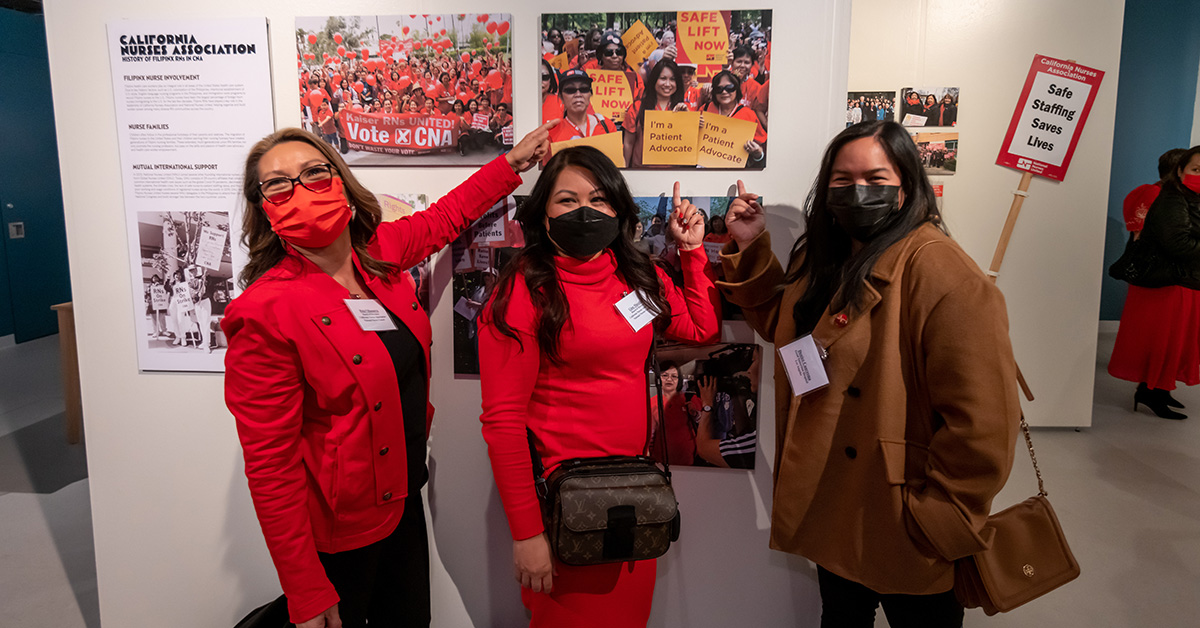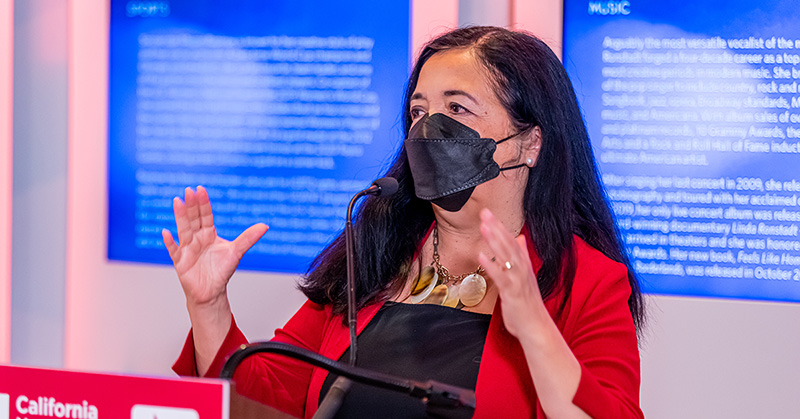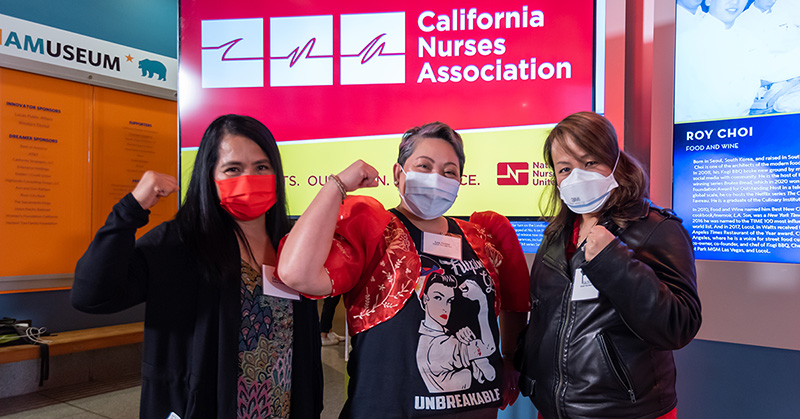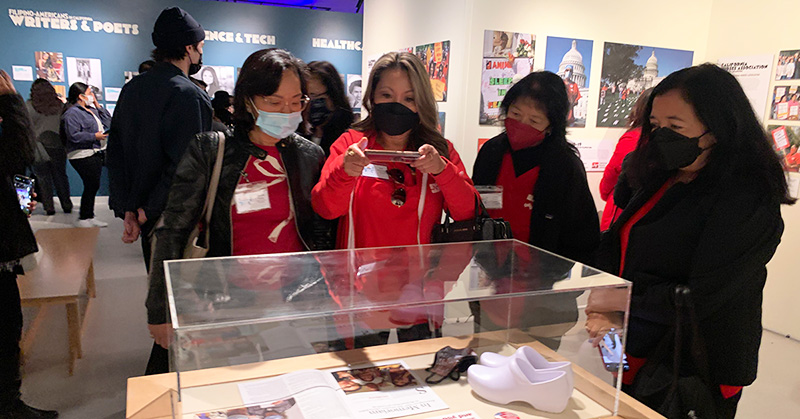Nursing is in the heart

History and legacy of Filipnx nurses featured in California Museum exhibit
By Rachel Berger
National Nurse Magazine - Jan | Feb | Mar 2023 Issue
“Ang mabigat ay gumagaan, kung pinagtutulungan.”
Anything that is heavy can be light if we put our resources together. Filipinx proverb
At the core of Filipinx culture lies the Bayanihan spirit, the abiding belief that cooperation and unity are fundamental to achieving what may appear on the surface to be impossible goals.
The Bayanihan spirit is the spirit of collective power, a mirror reflection of union power. It is this spirit that makes Filipinx RNs natural leaders in the labor movement and the California Nurses Association (CNA), National Nurses United’s (NNU) largest affiliate.
“Filipinx nurses have been key to the growth and success of this union,” said Bonnie Castillo, RN, and executive director of NNU as well as CNA and National Nurses Organizing Committee (NNOC). “I am so proud to have worked and more than that, fought alongside so many mighty Filipinx nurses.”
While the Filipinx population is one of the largest Asian American groups in California, the history of Filipinx people is often overlooked.
But a new exhibit at the California Museum, located in Sacramento, Calif., seeks to remedy that deficit by shining a light on the contributions of the Filipinx community. The “California is in the Heart” exhibit is a comprehensive look at the history of the Filipinx American experience. The exhibit grew out of a partnership between the California Nurses Association and the UC Davis Bulosan Center for Filipino Studies.
“People of color, including Filipino people, do not very often see themselves in museums and other major cultural institutions,” said Dr. Robyn Magalit Rodriguez, the founder and current director of the Bulosan Center. “Working people in general are often sidelined while the so-called great men of history, corporate heads, politicians, and the like [are celebrated]. For this exhibition, it was vital to celebrate the true heroes of our community.”

The exhibit lays out the highlights of the Filipinx experience in California, starting from their first landing at Morro Bay in 1587, through the labor and civil rights movements of the 1960s, to current leadership in local and statewide office.
Activists, community and labor organizers, entertainers, scientists, writers, thinkers, and many more are represented in displays that include stunning portraits and vivid paintings. The title of the exhibit was inspired by Filipinx immigrant activist Carlos Bulosan’s semi-autobiographical novel, “America is in the Heart,” which grapples with both the promise of the U.S. dream and the scourge of racism and xenophobia.
These are themes that are very familiar to the Filipinx nurses, both American born and those who came to the United States to escape political persecution, poverty, or find more opportunity. These experiences are what seeded their inspiration to organize with CNA.
It is the story of our union nurses that makes up the heart of the exhibit, both literally and figuratively, a multi-part display highlighting the work of Filipinx nurses and the California Nurses Association. The display brought a rush of pride, honor, and a sense of dignity to many of the more than 50 union nurses who visited the museum together in February.
“It is really emotional, really tearful,” said Rida Villanueva, RN, and a CNA/NNOC board member, seeing her own history and her image reflected on the walls of the museum.
Villanueva stood below a photograph of herself standing with fellow board members Gina Macalino, RN and former board member Debbie Cuaresma, RN. While Villanueva joked that it was not the most flattering photo (she recalled she had slept very little before it was taken during a D.C. protest) but she said, she felt enormous pride to see the nurses history being told. “It’s surreal,” she said.
Cuaresma’s daughter, Denice, herself an RN at Good Samaritan in Los Angeles, echoed the sentiment, after she spotted the photo of her mother from across the room when she saw her familiar sunglasses.
“It’s kinda overwhelming,” said Denice, who remembers making picket signs with her mother when she was a young girl. But she said it is remarkable to see her mother’s union work being honored. “She was a nurse to everyone, it’s really inspiring.”
“I feel seen,” said Macalino, reflecting on the exhibit. “It’s really important that the young people know what we have done. So the younger kids can see like, ‘Oh wow, they’ve done it before, I can do it myself.’”

The exhibit, which runs until the end of April, provides a brief history of the California Nurses Association from its beginnings in the early 1900s as the first union of nurses to address issues in the workplace to its current fierce advocacy for safe working conditions for nurses and care for patients. Other highlights include the CNA staff nurse revolution in 1992, which more clearly aligned CNA’s mission with bedside and staff nurses and the long and bruising, but victorious, fight in 1999 for a safe staffing ratios law.
“We have ambitious goals, many we have met, to unionize large numbers of hospitals,” Castillo told the nurses. “There’s no doubt in my mind that we could not have won those victories without Filipinx nurses and their passion, commitment, and talent for organizing -- organizing coworkers in their units, their hospitals, and even their church and community networks.”
It’s that kind of effective organizing and advocacy that nurses are so pleased to see celebrated in a museum setting and to share with new nurses.
“It lends credibility and respect to our work,” said Michelle Gutierrez-Vo, RN, and CNA/NNOC board member. “This is something to be proud of, and to display and show the world.”

“Our stories matter,” said Jane Sandoval, RN and CNA/NNOC board member. “Just when you think no one’s paying attention, someone is paying attention.”
And that “paying attention” is how the new generation of nurses learn to carry on the fight for health care justice in California communities and in their facilities.
“You get to tell other nurses, not just Filipina but young nurses all over the country, that your ideas, everything you bring to the table counts,” said Gutierrez-Vo. “I have mentored others who have learned to stand for themselves and have a voice. The best thing you can do is to teach people to stand on their own two feet.”
“My heart is so full that my Filipinx sisters, brothers, and siblings are being recognized for all that we have contributed to the history of California,” said Zenei Triunfo-Cortez, RN and the first Filipina president of a major national union, both NNU and CNA. Triunfo-Cortez is celebrated with her own display, an acknowledgement of her special place in history.
“When my sisters saw that, they really began taking photos,” said Triunfo-Cortez adding humbly she is not quite sure why she’s the one who is singled out for the accomplishments of so many, and ending with a laugh, “But, hey, I will take it!”
But on a more serious note, Triunfo-Cortez said, “I know I stand as an important symbol for all of us Filipinx nurses and the power all of us have when we stand together. My aim is that while I am the first Filipinx president of our organization, I should not be the only, but rather the first with many more to follow.”
Rachel Berger is a communications specialist at National Nurses United.